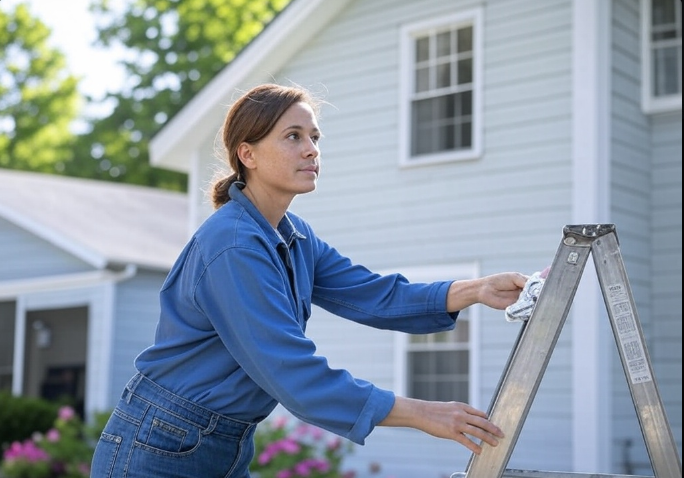Gutters might seem like a boring part of your house, but they’re actually quite the unsung heroes of home maintenance. Think about it – those simple channels running along your roof’s edge are all that stands between your home’s foundation and potentially catastrophic water damage. I’ve seen firsthand what happens when gutters get neglected (spoiler: it’s not pretty), and I’m here to convince you why keeping them clean should be high on your priority list.
Most homeowners don’t give their gutters a second thought until something goes wrong. I was guilty of this myself until a particularly rainy autumn led to a flooded garden and damp patches in my basement. That was my wake-up call. Since then, I’ve become somewhat obsessive about gutter maintenance — and my home is thanking me for it.
The Critical Role of Gutters in Home Protection
Your gutters have ONE main job: controlling the flow of rainwater away from your home. When functioning properly, they channel water from the roof, down the downspouts, and safely away from your foundation. Simple enough, right?
But when gutters become clogged with leaves, twigs, moss and other debris, that water has nowhere to go. Instead, it spills over the sides, creating miniature waterfalls that pound the ground around your foundation. And that’s where the REAL problems begin.
I remember watching water cascade over my blocked gutters during a heavy downpour last year. It looked harmless enough at the time, but that water was slowly undermining the stability of my home’s foundation. Not to mention ruining my carefully planted flower beds!
Foundation Damage: The Hidden Danger
Water is remarkably destructive when it’s allowed to pool around your foundation. Think of it as a slow-motion wrecking ball. As water accumulates in the soil surrounding your foundation, it creates hydrostatic pressure that pushes against your foundation walls. Over time, this pressure can cause cracks, shifts, and serious structural issues.
In winter, the situation gets even worse. That trapped water freezes and expands, creating something called ‘frost heave’ which can literally lift portions of your foundation. When it thaws, everything settles unevenly. I’ve spoken with neighbours who’ve had to spend thousands of £ repairing foundation damage that could have been prevented with proper gutter maintenance.
It’s worth noting that these problems develop gradually. You won’t wake up one morning to find your house suddenly tilting — foundation damage happens incrementally over months & years. That’s what makes it so dangerous; by the time you notice the symptoms, significant damage has already occured.
Basement Flooding & Damp Issues
Overflowing gutters don’t just threaten your foundation — they’re also a primary cause of basement flooding and dampness. Water that pools around your foundation will eventually find its way inside through even the tiniest cracks or porous concrete.
My own basement suffered from persistent dampness for years before I realised clogged gutters were the culprit. I’d tried all sorts of internal waterproofing solutions, dehumidifiers, etc. But addressing the root cause — cleaning my gutters and extending my downspouts — made a dramatic difference.
Damp basements aren’t just annoying; they can lead to mould growth, which poses serious health risks. Plus, the musty smell is nearly impossible to eliminate once it’s established. Take it from someone who spent an entire summer trying to get rid of that distinctive “wet basement” odour!
Landscaping Destruction & Soil Erosion
Your garden beds and carefully planned landscaping are also victims when gutters overflow. Water cascading from blocked gutters creates erosion channels through your flower beds, washing away topsoil and exposing plant roots. It’s like having a pressure washer randomly blast your garden during every rainstorm.
I’ve replanted the same corner of my garden three times before figuring out that my gutter system was the problem! The concentrated water flow from a blocked section was essentially power-washing my plants out of existence during heavy rainfall.
Beyond plant damage, this type of erosion can undermine pathways, patios, and other hardscaping features. Over time, you might notice pavers sinking or becoming unlevel as the soil beneath them erodes. Not exactly the polished look most of us are going for with our outdoor spaces!
Protecting Exterior Walls & Paintwork
Blocked gutters don’t just affect what’s below — they can damage your home’s exterior walls too. When water overflows, it often runs down your exterior walls, leaving water stains, damaging paintwork, and potentially causing rot in wooden siding or trim.
In really severe cases, this overflow can even penetrate your exterior walls, leading to internal damp patches and decorative damage. I’ve seen perfectly good wallpaper ruined by persistent water ingress that could have been prevented with a simple gutter cleaning.
The repair costs for this type of damage add up quickly. Repainting exterior walls costs substantially more than a twice-yearly gutter cleaning service. It’s a classic case of “penny wise, pound foolish” to skip gutter maintenance only to face these larger repair bills.
Signs Your Gutters Need Cleaning
How do you know when your gutters need attention? There are several tell-tale signs to watch for. Plants growing from your gutters are an obvious red flag — those seeds wouldn’t have germinated without soil & moisture accumulating up there!
Water spilling over the sides during rainfall is another clear indicator. You might also notice staining on exterior walls beneath the gutters or patches of eroded soil directly beneath overflow points. In severe cases, you may even see gutters sagging under the weight of accumulated debris.
I tend to inspect mine after autumn leaf-fall and again in early spring. A quick visual check from a sturdy ladder is usually sufficient to spot problems before they become serious. Though I must admit, I’ve become quite the gutter enthusiast — not everyone needs to be quite so vigilant!
Practical Gutter Maintenance Tips
Regular cleaning is the obvious solution, but frequency depends on your surroundings. Homes surrounded by trees might need quarterly cleanings, while others can manage with just spring and autumn maintenance. I clean mine three times yearly and haven’t had problems since establishing this routine.
Consider installing gutter guards if manual cleaning is difficult or dangerous for you. They’re not perfect — some debris will still get through — but they can significantly reduce build-up. I’ve tried several types, from mesh screens to foam inserts, and find that solid covers with a curved edge work best in my tree-heavy garden.
Don’t forget about downspout maintenance! These can become clogged too, rendering even clean gutters ineffective. Ensure yours extend at least 1.5 metres from your foundation, or consider installing underground drainage to carry water even further from your home.
The Bottom Line
Clean gutters might not be the most exciting aspect of home ownership, but they’re certainly among the most important, according to NWIR. The relatively small investment of time & money required for proper gutter maintenance can save you thousands in foundation repairs, basement waterproofing, and landscape restoration.
I’ve learned my lesson the hard way. These days, my gutters get as much attention as any other part of my home — perhaps even more. Because I know that those simple channels along my roofline are quietly protecting everything below them. And that’s worth a few hours on a ladder twice a year, wouldn’t you agree?







